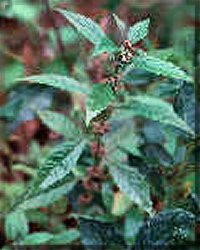

Lycopus virginicus Lycopus Europaeus


Lycopus
virginicus Lycopus
Europaeus
Description - Occasional on the shore above the tide-line. Stems are 30-80 cm, flowers ar 3 mm across, general look and feel of the leaves is typical of the Labiate family, rather nettle-like, but they are unique in having deep toothing; shallowest at tip and deepest at the base where it often reaches the midrib. Even plants without flowers should be recognisable from these pictures alone. Flowers are small, in whorls at base of upper leaves, much more regular than most Labiates, similar to Mint flowers, but white, with some purple spots on the lowest of the 4 petals.
Pharmacology - The primary chemical constituents of Bugleweed are known to include tannins, lithospermic acid, lycopine, flavoneglycosides, phenolic derivatives (caffeic acid, chlorogenic acid, ellagic acid, rosmarinic acid), essential oil, magnesium, and resin. Lithospermic acid and other organic acids are believed to be responsible for Bugleweed’s activity. These acids decrease levels of several hormones in the body, particularly thyroid-stimulating hormones and the thyroid hormone thyroxine. Bugleweed inhibits the binding of antibodies to the thyroid gland. Recent research shows an anti-hormonal, particularly anti-thyrotropic, activity for this herb. Bugleweed is used specifically in Grave's disease (with cardiac involvement) - whiche is an autoimmune disorder that affects the thyroid gland and eye muscles. The thyroid gland produces hormones that control many of the body's chemical functions, including how muscles relax and contract. Graves' disease causes the thyroid gland to produce too much thyroid hormone (hyperthyroidism). Signs and symptoms of this include diarrhea, rapid heart rate, inability to tolerate heat, and weight loss. Bugleweeds action is less powerful than that of synthetic drugs, but is usually adequate in less severe cases and safe for long-term treatment. It increases the force of myocardial contraction and reduces heart rate
Medicinal Uses - One of the main uses of Bugleweed is to reduce the activity of an overactive thyroid, including the racing heart that often accompanies that condition. This herb calms the spirit, and quiets the pulse & heartbeat, thus helping to reduce or eliminate palpitations. Bugleweed is used specifically in Grave's disease with cardiac involvement where the symptoms include tightness of breathing, palpitations and shaking. Its action is less powerful than that of synthetic drugs, but is usually adequate in less severe cases and safe for long-term treatment. It increases the force of myocardial contraction and reduces heart rate; it is indicated in nervous tachycardia. Bugleweed is a specific for over-active thyroid glands, especially where the symptoms include tightness of breathing, palpitation and shaking. It may safely be used where palpitations occur that are of nervous origin. Bugleweed will aid the weak heart where there is associated build-up of water in the body. As a sedative cough reliever it will ease irritating coughs, especially when they are of nervous origin.
Dosages:
Contra-indications - Do not take Bugleweed without talking to your doctor first if you are taking thyroid hormone replacement medicines (levothyroxine (Synthroid(R)); thyroid (Armour Thyroid(R))). Before taking Bugleweed, tell your doctor if you are pregnant or breastfeeding Warnings: